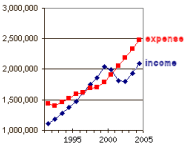In the previous post, Neoconservatives or Neo Con-Men? The Project:, I was discussing Rebuilding America’s Defenses, the P.N.A.C. White paper from September 2000. There were two arguments in the report. The first is obvious from the title. The panelists argued that Clinton’s cutting the Defense Budget had made America vulnerable to danger from all fronts. We needed to catch up to the levels of Military spending in the Reagan years – the golden age. The report suggests a number of changes in deployment and new weapons, an aggressive increase in our Military force and presence in the world.
But then there was a second argument. The cynical view of this second line of thought would be that the level of Military they were suggesting wasn’t justified by the first argument, since we were at peace and the Soviet Union had fallen. Considering what ensued after Bush was elected, I think my cynicism is justified. The second argument was a broad reframing of American Foreign Policy.
After the victories of the past century – two world wars, the Cold War and most recently the Gulf War – the United States finds itself as the uniquely powerful leader of a coalition of free and prosperous states that faces no immediate great-power challenge. The American peace has proven itself peaceful, stable and durable. It has, over the past decade, provided the geopolitical framework for widespread economic growth and the spread of American principles of liberty and democracy. Yet no moment in international politics can be frozen in time; even a global Pax Americana will not preserve itself.

It’s impossible to read the Project for the New American Century without musing about less savory motives. Two come to mind quickly – some version of conquest [dominion over the energy sources eg oil], and maintaining the Military Industrial Complex’s fiscal well-being. How would one tell the difference between the wisdom of such a peacetime buildup in military strength for the lofty reasons given, or simply the profits of the energy and military industries? From here in the future, I believe we can answer that question based on "the decision."
The Decision
On September 11th, 2001, the United States of America was maliciously attacked by a rogue organization of Islamic Terrorists known as Al Qaeda. We knew a lot about Al Qaeda. In fact we had a strong suspicion they were about to attack us in some way or another. They’d already had a shot at the World Trade Towers. When George W. Bush and Dick Cheney came into the White House, the C.I.A. and Counterterrorism Adviser Richard Clarke repeatedly warned the new heads of State about the danger. They were ignored. When we were attacked, we dawdled. When we finally went into Afghanistan where Al Qaeda had been centered, they were on the run, probably to the wilderness of Pakistan. So there came a time when a decision needed to be made.
Our enemy was clear, the Al Qaeda terrorist organization of Osama Bin Laden. But the motives of the Neoconservatives of the Project for the New American Century were also clear – American "interests" in the Persian Gulf [oil fields] and the Military Industrial Complex at home. We had a choice to make, a clear choice. Do we patiently focus our attention on our enemy, Osama Bin Laden and Al Qaeda – working with countries in the region until we locate him and find a way to take our war to him? Or do we carry on with the plans of the P.N.A.C.? Are our motives National Defense? or Are our motives those of the Military Industrial Complex and the Energy Conglomerates?
They made "the decision." So we now know the answer to the question about motives. And we now know the forces that drive the Neoconservatives that have taken over our government. Neoconservativism is not an ideology in the way we traditionally think of ideologies. It is a plan. Their think-tanks are not about thinking, they’re about doing.
Sorry, the comment form is closed at this time.